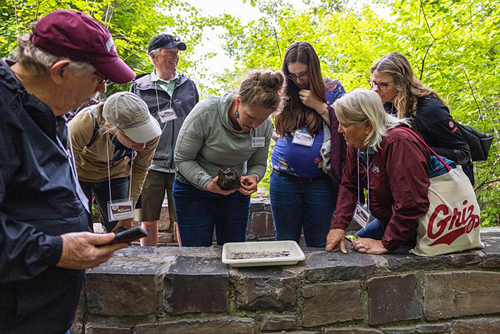UM Bio Station Receives $6.6 million EPA Grant to Fight Pesticide Pollution

FLATHEAD LAKE – The University of Montana recently was awarded $6.6 million from the Environmental Protection Agency’s Columbia River Basin Restoration Program.
Dr. Rachel Malison, an assistant professor with UM’s Flathead Lake Biological Station, will use the funding to develop and implement a comprehensive and collaborative Pesticide Stewardship Partnership Program for Montana’s Upper Columbia River Basin.
The program will focus on reducing pollution to improve water quality, while engaging and educating the public on ways to reduce toxics from polluting Montana’s pristine waters.
“We are extremely excited for this EPA grant award,” said Malison. “This program will allow us to greatly expand our current work through the bio station’s Monitoring Montana Waters program in ways that will leverage community-led, citizen-based partnerships.
“Through the engagement of multiple stakeholders, producers, agencies and the general public, we hope to reduce pesticides and toxics in the upper Columbia River Basin over the next five years,” she added.
Covering an area of 260,000 square miles, the Columbia River Basin reaches 17 federally recognized tribes and seven states: Montana, Idaho, Washington, Oregon, Wyoming, Nevada and Utah. The Columbia Basin provides significant ecological benefits to these regions and supports critical economic industries, such as commercial fisheries, agriculture, forestry, recreation and electric power generation. Montana’s portion of the Columbia Basin includes the Clark Fork, Kootenai and Flathead rivers.
“This project is among several that the EPA is supporting to address critical water quality needs in the Columbia River watershed,” said EPA Regional Administrator KC Becker. “Dr. Malison and her team have put together a much-needed and comprehensive program to develop data and use community engagement to reduce harmful pesticides affecting our waters. This grant is an investment in the health of northwest Montana’s rivers and streams, aquatic ecosystems, and the people and economies that depend on them.”
Pesticides are substances that prevent, kill, repel or mitigate organisms that are harmful to cultivated plants or animals (“pests”). Pesticides often target insects (insecticides), but also include those that target plants (herbicides), fungi (fungicides) and even rodents (rodenticides). Despite the enactment of the Clean Water Act in 1972, pesticide contamination in lakes and streams in the Columbia River Basin remains a concern today. Human activities add toxic contaminants to the environment that contribute to human health and ecosystem risks.
Throughout the basin, fish have accumulated contaminant levels that are harmful to people and wildlife when eaten. Toxics in fish are a primary health concern for Columbia River Basin Tribal people and other high fish consumers. Toxics also have negative impacts on the rest of the food web and very little is known about how pesticides influence aquatic systems in Montana.
To date, there has been no comprehensive pesticide monitoring program in western Montana, which is where Malison’s new program can make an immediate impact.
Building upon the successful Pesticide Stewardship Partnership Program in Oregon, Malison’s program will include targeted water quality sampling for pesticides; implementation of actions to reduce pesticides in urban, residential and agricultural areas; and monitoring for successful implementation.
Some of the planned activities include green infrastructure projects to treat stormwater, increased residential and commercial pesticide waste collections, and educational watershed tours. All of the program activities will improve water quality by preventing toxics from entering the environment.
Working in collaboration with the Montana Department of Agriculture, the Montana Department of Environmental Quality, Montana State University and others, the new program will leverage matching resources to increase the impact of the program. Additionally, participating stakeholders will engage in sampling, education and outreach and lead actions to improve Montana’s waters.
This project will also work in collaboration with the Confederated Salish and Kootenai Tribes and the Kootenai Tribe of Idaho to address risks to human health from consumption of pesticides in fish.
With clean water being a critical resource for all people and aquatic ecosystems, Malison hopes this project can create a lasting legacy for future generations.
“This funding enables us to build a network of stakeholders to implement projects on the landscape and better protect our waters,” said Malison. “We look forward to developing a set of resources that can be used by all – from residential users to producers – that will help us reduce the impact of pesticides on our waters and the aquatic communities that live in them. We also hope that this program will set the stage for further work on toxics reductions throughout the entire state of Montana.”
For more information about the EPA Columbia River Basin Restoration Program, visit their website at https://www.epa.gov/columbiariver/about-epas-work-columbia-river-basin#crbrp.
More information about UM’s new Pesticide Stewardship Partnership Program and educational resources are forthcoming on the Flathead Lake Biological Station website. For more information about the program email Malison at rachel.malison@umontana.edu or Janelle Housman, the project coordinator, at janelle.housman@flbs.umt.edu.
###
Contact: Rachel Malison, UM Flathead Lake Biological Station assistant research professor, 406-872-4518, rachel.malison@umontana.edu; Tom Bansak, FLBS associate director, 406-872-4503, tom.bansak@umontana.edu